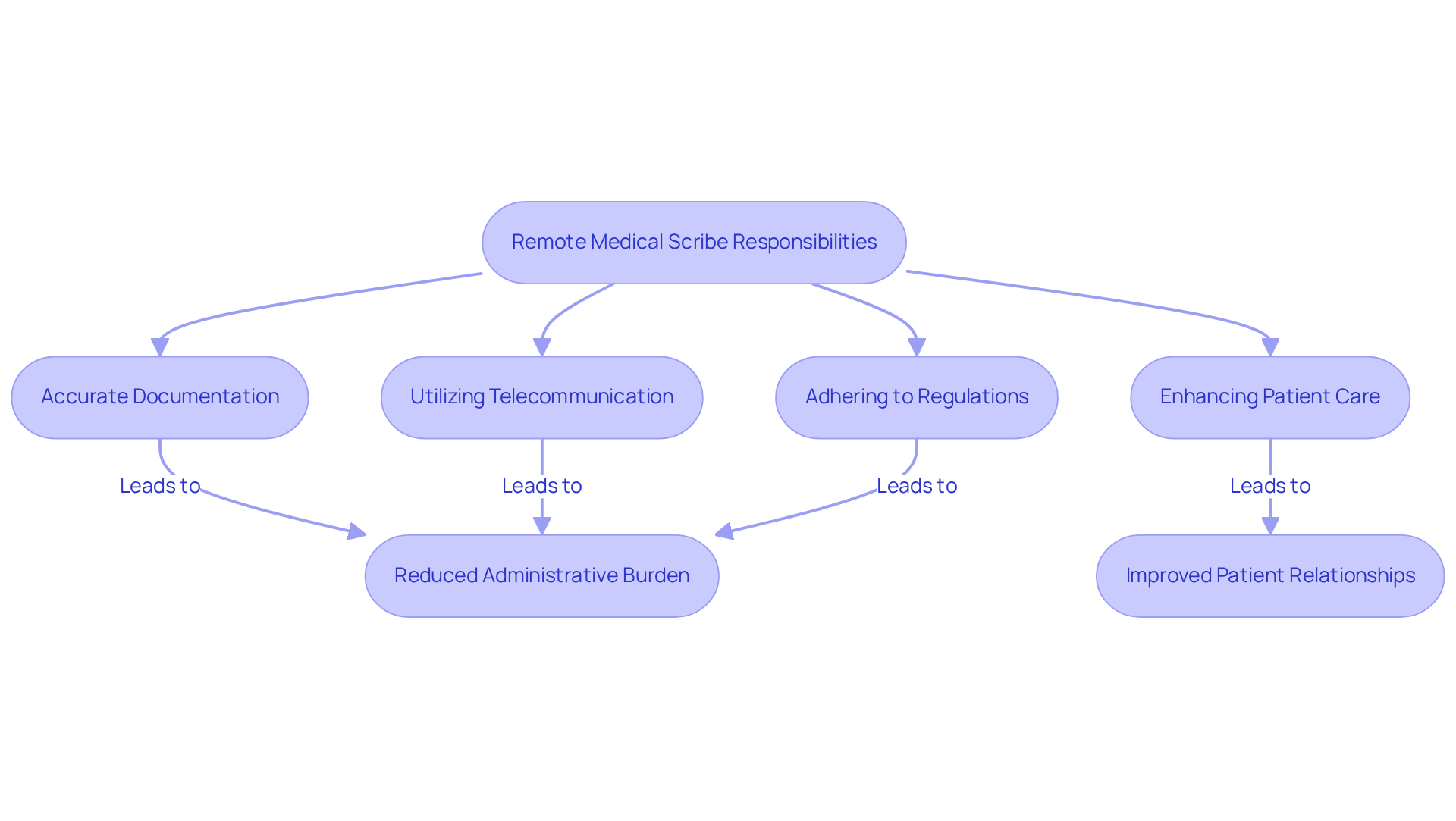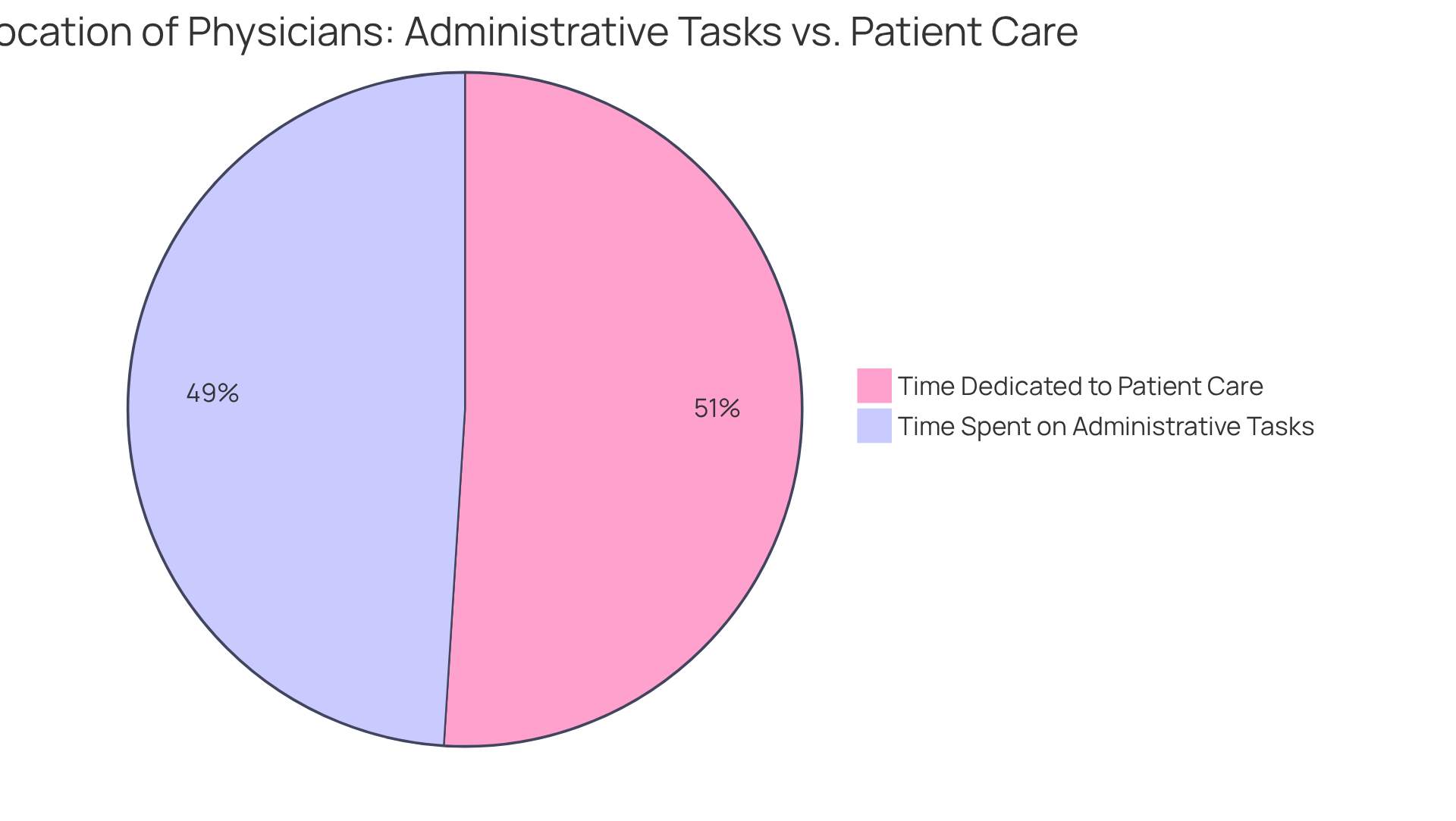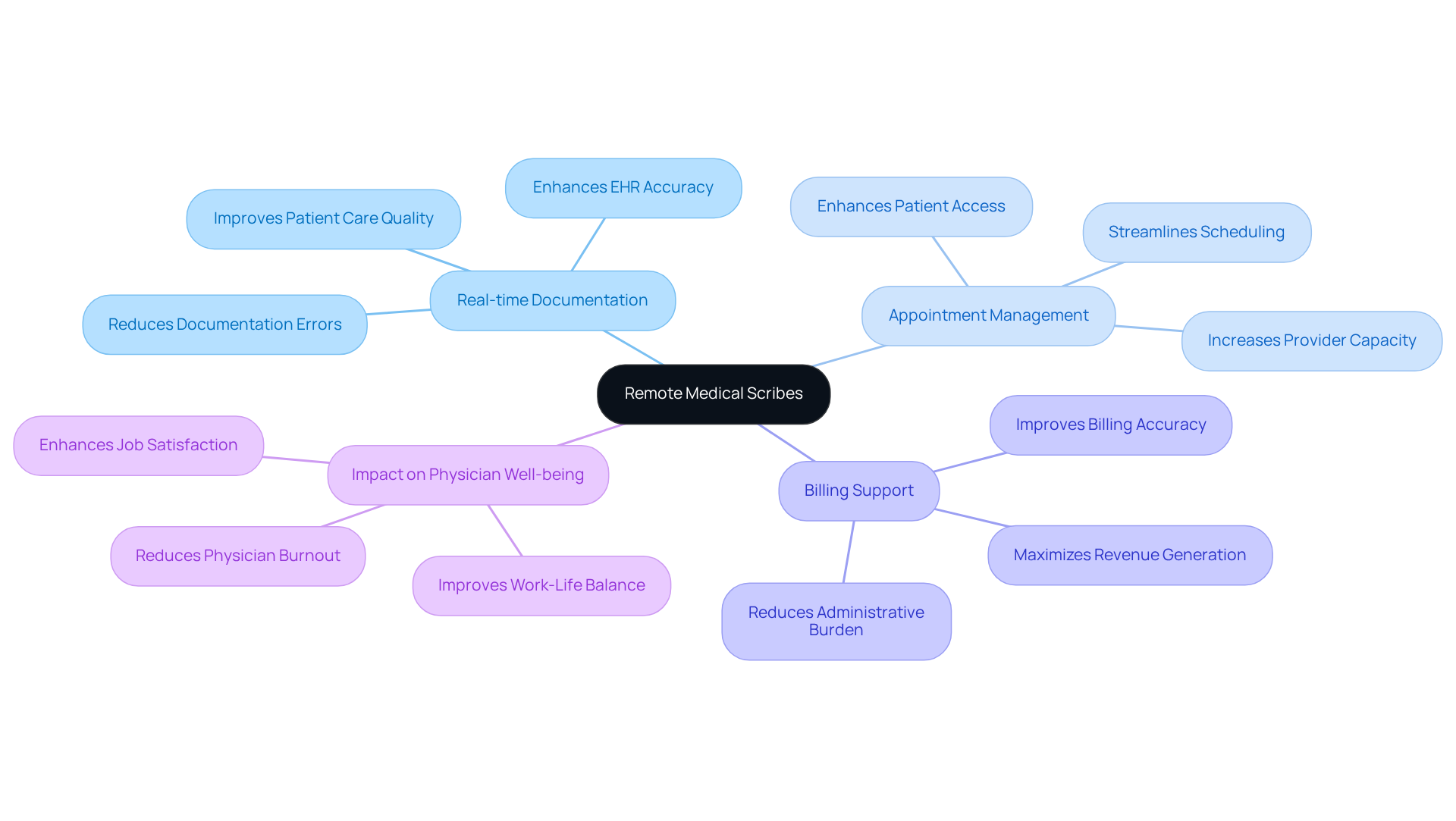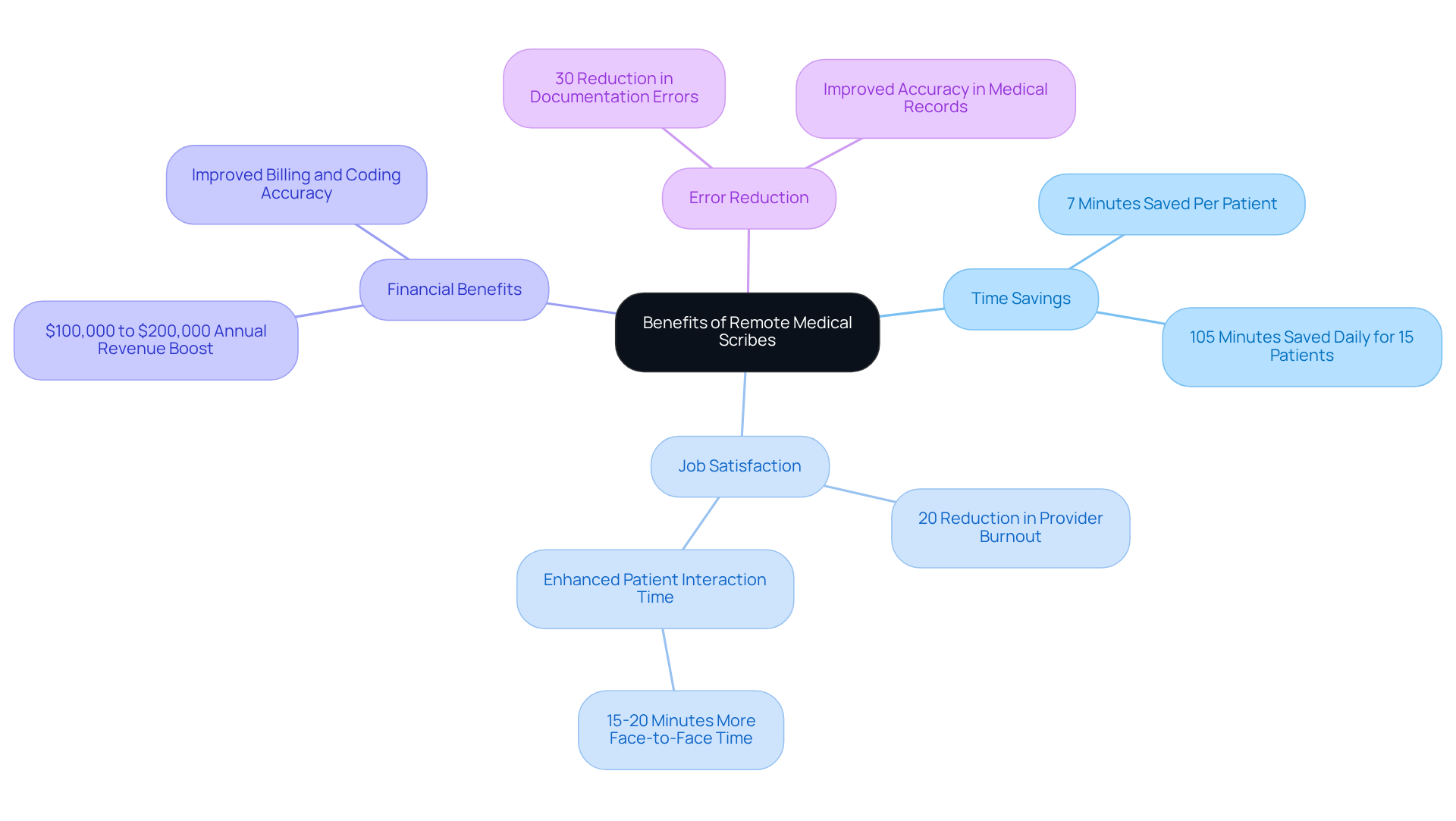Overview
Healthcare providers often face overwhelming emotional challenges, juggling patient care with the demands of administrative tasks. Remote medical scribes offer a compassionate solution, managing medical documentation from off-site locations. This support allows healthcare professionals to focus more on what truly matters—providing exceptional patient care.
Imagine a world where your administrative burdens are lifted, enabling you to connect more deeply with your patients. These dedicated scribes not only improve efficiency but also reduce burnout among healthcare providers. By enhancing patient-provider interactions, they contribute to better healthcare outcomes and increased revenue for medical practices.
Isn’t it time to consider how this support could transform your practice? Embracing the help of remote medical scribes could lead to a more fulfilling work environment for you and better experiences for your patients. Together, we can create a healthcare landscape where providers thrive and patients receive the care they deserve.
Introduction
In the fast-paced world of healthcare, the burden of administrative tasks often weighs heavily on providers, detracting from their primary mission: patient care. This can lead to stress and frustration, affecting not only the providers but also the quality of care patients receive. Enter the remote medical scribe—a pivotal player in alleviating this pressure and enhancing the efficiency of healthcare delivery.
By expertly managing documentation from afar, these professionals not only streamline workflows but also empower clinicians to focus on what truly matters: their interactions with patients. Imagine the relief when providers can dedicate more time to patient care rather than paperwork. Yet, as the demand for these remote assistants grows, one must ask: how do remote medical scribes transform the landscape of healthcare, and what are the tangible benefits they bring to both providers and patients?
Consider the impact: with reduced administrative burdens, healthcare providers can foster stronger relationships with their patients, leading to improved outcomes and satisfaction. As we explore this topic, let's reflect on the significant role these scribes play in the healthcare ecosystem and the positive changes they can bring to both providers and patients alike.
Define Remote Medical Scribe: Role and Responsibilities
In the demanding world of healthcare, providers often face overwhelming administrative burdens that can detract from their ability to deliver compassionate care. A distant medical assistant serves as a vital support system, and understanding what does a remote medical scribe do reveals their expert training in handling medical documentation from an off-site location. By utilizing telecommunication platforms, these professionals ensure that patient interactions are recorded with precision, allowing healthcare practitioners to focus on what truly matters—their patients.
Imagine the relief when medical histories, physical examinations, and treatment plans are transcribed accurately and efficiently, all while adhering to strict medical regulations. This automation not only alleviates the administrative load on providers but also empowers them to reclaim precious time. With this newfound time, they can devote more attention to their clients during consultations, enhancing the overall patient experience.
Ultimately, what does a remote medical scribe do is not just about paperwork; it’s about fostering better relationships between providers and patients. By streamlining documentation processes, these professionals contribute to a more effective healthcare service, allowing practitioners to focus on delivering high-quality care. If you’re feeling the weight of administrative tasks, consider how a distant medical assistant could transform your practice and improve your connection with your clients.

Contextual Importance of Remote Medical Scribes in Healthcare
The rise of distance medical assistants directly addresses the increasing administrative pressures that healthcare professionals face. As healthcare systems evolve, clinicians often feel overwhelmed by the need to meticulously document interactions with patients while upholding high standards of care. Did you know that physicians spend nearly half of their day—49%—on electronic medical records and administrative tasks? This statistic underscores the vital role of off-site assistants in improving time efficiency and reducing burnout.
To understand what a remote medical scribe does, it's important to note that they are essential in alleviating this burden, allowing providers to prioritize client engagement over documentation. This shift is especially crucial in the telehealth sector, where understanding what a remote medical scribe does is essential for seamlessly integrating into virtual consultations, ensuring that documentation is managed effectively and accurately. By handling routine administrative tasks, off-site assistants not only enhance clinician-client interactions—57% of individuals appreciated their doctor dedicating more time to them rather than focusing on computers when an assistant was present—but also contribute to improved care quality and reduced burnout among medical providers.
Moreover, the financial implications of administrative burdens are significant, costing the medical system an estimated $15.5 billion annually. By employing remote assistants, medical practices can potentially increase income through a higher number of clients while lowering operating costs, as these assistants do not require office space or equipment. Isn't it time to consider how remote medical assistants can transform your practice for the better?

Key Functions and Daily Activities of Remote Medical Scribes
Remote medical scribes are essential in enhancing healthcare delivery, addressing the emotional challenges faced by providers. They engage in virtual consultations, listening attentively to the interactions between clients and providers, documenting these conversations in real-time. This immediate documentation is crucial for maintaining accurate electronic health records (EHR), ensuring that relevant patient information is updated as consultations occur. Additionally, off-site clerks manage appointment schedules and assist with billing documentation, ensuring that all essential information is recorded effectively.
By taking on these responsibilities, off-site medical assistants significantly bolster the capabilities of medical providers. Research indicates that doctors utilizing distant assistants can consult with an average of 5 to 10 additional individuals each day. This increase can lead to a potential revenue boost of $125,000 to $200,000 annually for medical facilities. Moreover, providers leveraging remote medical documentation can improve access to individuals by up to 25-50%, underscoring the profound impact of remote documentation on healthcare delivery. Incorporating writers into clinical processes has been shown to reduce physician exhaustion by 30-40%, allowing providers to focus more on patient care rather than administrative tasks. This statistic is supported by research indicating that doctors collaborating with medical assistants experience a notable decrease in burnout, enhancing their overall well-being.
Specialist perspectives emphasize the importance of distant notetakers in patient consultations, noting that their involvement not only improves documentation accuracy but also elevates the overall quality of care. For instance, Dr. Sirivan S. Seng highlights that medical assistants enhance physician-patient interactions and streamline workflow. As medical services evolve, the role of remote medical assistants becomes increasingly vital, ensuring that providers can deliver compassionate and efficient care while managing the complexities of modern medical documentation. Furthermore, the onboarding process for these note-takers is efficient, requiring just one hour of training before they can begin contributing to medical practices.

Benefits of Utilizing Remote Medical Scribes for Healthcare Providers
Healthcare providers often face overwhelming emotional challenges due to the heavy administrative burdens they carry. The incorporation of virtual medical assistants offers a compassionate solution, significantly alleviating these pressures. By reducing the administrative load on clinicians, these assistants allow providers to reclaim valuable time, which can be redirected towards caring for individuals.
Imagine saving an average of 7 minutes for each patient. For a physician attending to 15 individuals in a day, that translates to almost 2 hours saved! This shift not only enhances job satisfaction among healthcare professionals but also fosters more meaningful interactions with patients, ultimately leading to improved patient outcomes.
Moreover, remote note-takers enhance efficiency in documentation, resulting in quicker billing processes and better revenue cycles. Medical assistants can help providers boost revenue by $100,000 to $200,000 annually, underscoring the financial advantages of their utilization. With a reported 30% decrease in documentation mistakes, as highlighted by the Journal of the American Medical Informatics Association, the precision of medical records improves significantly, enhancing safety and care effectiveness.
Overall, what a remote medical scribe does can lead to a more streamlined and effective healthcare delivery system. This not only benefits providers but also enriches the experience for patients. Are you ready to explore how virtual medical assistants can transform your practice and improve patient care?

Conclusion
In today’s healthcare landscape, the role of a remote medical scribe is truly pivotal. These professionals provide essential support, allowing medical providers to focus on what matters most: patient care. By managing documentation from a distance, remote scribes streamline processes and enhance the quality of care, nurturing stronger relationships between clinicians and patients.
Throughout this article, we’ve explored the myriad benefits of utilizing remote medical scribes. Have you considered how improving documentation accuracy and reducing physician burnout could transform your practice? These assistants alleviate the administrative burdens that often overwhelm healthcare providers, increasing efficiency and potential revenue. The statistics presented reveal significant time savings and financial advantages, underscoring their value in enhancing both clinician and patient experiences.
As the healthcare industry evolves, embracing the support of remote medical scribes is not merely a trend; it’s a necessary shift towards more efficient and compassionate care. For healthcare providers seeking to improve their practice, investing in remote medical scribing services can lead to transformative changes. Imagine the positive impact on both providers and patients alike. It’s time to recognize the profound influence of these professionals and consider how their expertise can help reshape the future of healthcare delivery.




